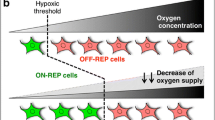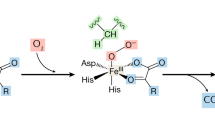Summary
The glycoprotein hormone erythropoietin (EPO) counteracts tissue hypoxia by increasing the systemic oxygen-carrying capacity. It induces augmentation of red blood cell mass by stimulating the formation and differentiation of erythroid precursor cells in the bone marrow.
EPO production is increased under various forms of diminished oxygen supply such as anemic or hypoxic hypoxia. In the adult organism, the kidneys are the major source of EPO. The precise nature of the cells responsible for renal EPO production, however, has not yet been elucidated. Most likely, peritubular cortical cells, e.g. interstitial or endothelial cells, are involved in the elaboration of the hormone. From the observation that isolated perfused rat kidneys produce EPO in an oxygen-dependent fashion we conclude that the ‘oxygen sensor’ that controls hypoxia-induced EPO synthesis is located in the kidney itself. Within the kidneys, the local venous oxygen tension which reflects the ratio of oxygen supply to oxygen consumption is measured and transformed into a signal that regulates the formation of EPO. However, the mechanism by which a decrease of oxygen delivery to the kidneys is linked to an enhanced EPO gene expression is not yet known. Two possible mechanisms of regulation are discussed: First, renal hypoxia could lead to enhanced formation of metabolic mediators, for example prostaglandins or adenosine, which might stimulate EPO gene transcription by increasing cellular levels of second messenger molecules. Second, some kind of molecular ‘oxygen receptor’ such as a heme protein, that controls EPO formation by an oxygen-dependent conformational change, could mediate signal transduction.
Similar content being viewed by others
References
Bauer, C., Metabolic events that may activate erythropoietin production in the hypoxic kidney, in: Oxygen Sensing in Tissues, pp. 93–101. Ed. H. Acker. Springer-Verlag, Berlin 1988.
Bauer, C., and Kurtz, A., Oxygen sensing in the kidney and its relation to erythropoietin production. A. Rev. Physiol.51 (1989) 845–856.
Beru, N., Mc Donald, J., Lacombe, C., and Goldwasser, E., Expression of the erythropoietin gene. Molec. cell. Biol.6 (1986) 2571–2575.
Bondurant, M. C., and Koury, M. J., Anemia induces accumulation of erythropoietin mRNA in the kidney and liver. Molec. cell. Biol.6 (1986) 2731–2733.
D'Andrea, A. D., Lodish, H. F., and Wong, G. G., Expression cloning of the murine erythropoietin receptor. Cell57 (1989) 277–285.
Deetjen, P., and Kramer, K., Die Abhängigkeit des O2-Verbrauchs der Niere von der Na-Rückresorption. Pflügers Arch.273 (1961) 636–650.
Eckardt, K. U., Kurtz, A., Hirth, P., Scigalla, P., Wieczorek, L., and Bauer, C., Evaluation of the stability of human erythropoietin in samples for radioimmunoassay. Klin. Wochenschr.66 (1988) 241–245.
Eckardt, K. U., Kurtz, A., and Bauer, C., Regulation of erythropoietin production is related to proximal tubular function. Am. J. Physiol.256 (1989) F942–F947.
Eckardt, K. U., Möllmann, M., Neumann, R., Brunkhorst, R., Burger, H. U., Lonnemann, G., Scholz, H., Keusch, G., Buchholz, B., Frei, U., Bauer, C., and Kurtz, A., Erythropoietin in polycystic kidneys. J. clin. Invest.84 (1989) 1160–1166.
Erslev, A. J., In vitro production of erythropoietin by kidneys perfused with a serum-free solution. Blood44 (1974) 77–85.
Erslev, A. J., Caro, J., Miller, O., and Silver, R., Plasma erythropoietin in health and disease. Ann. clin. Lab. Sci.10 (1980) 250–257.
Fisher, J. W., and Birdwell, B. J., The production of an erythropoietic factor by the in situ perfused kidney. Acta haemat.26 (1961) 224–232.
Fisher, J. W., Mc Gonigle, R., and Beckman, R., Control mechanisms in kidney erythropoietin production, in: Kidney Hormones, pp. 463–474. Ed. J. W. Fischer. Academic Press, London 1986.
Fisher, J. W., Pharmacologic modulation of erythropoietin production. A. Rev. Pharmac. Toxic.28 (1988) 101–122.
Fried, W., The liver as a source of extrarenal erythropoietin. Blood40 (1972) 671–677.
Gietzen, K., Sadorf, I., and Bader, H., A model for the regulation of the calmodulin-dependent enzymes erythrocyte Ca2+-transport ATPase and the brain phosphodiesterase by activators and inhibitors. Biochem. J.207 (1982) 541–548.
Goldberg, M. A., Dunning, S. P., and Bunn, H. F., Regulation of the erythropoietin gene: evidence that the oxygen sensor is a heme protein. Science242 (1988) 1412–1415.
Jacobs, K., Shoemaker, C., Rudersdorf, R., Neill, S., Kaufmann, J., Mufson, A., Seehra, J., Jones, S. S., Hewick, R., Fritsch, E. F., Kawakita, M., Shimizu, T., and Miyake, T., Isolation and characterization of genomic and cDNA clones of human erythropoietin. Nature313 (1985) 806–810.
Jacobson, L. O., Goldwasser, E., Fried, W., and Plzak, L., Role of the kidney in erythropoiesis. Nature179 (1957) 633–634.
Jelkmann, W., Temporal patterns of erythropoietin titers in kidney tissue during hypoxic hypoxia. Pflügers Arch.393 (1982) 88–91.
Jelkmann, W., Renal erythropoietin: properties and production. Rev. Physiol. Biochem. Pharmac.104 (1986) 140–215.
Jones, D. P., Renal metabolism during normoxia, hypoxia and ischemic injury. A. Rev. Physiol.43 (1986) 33–50.
Koury, S. T., Bondurant, M. C., and Koury, M. J., Localization of erythropoietin synthesizing cells in murine kidneys by in situ hybridization. Blood71 (1988) 524–527.
Koury, S. T., Koury, M. J., Bondurant, M. C., Caro, J., and Graber, S. E., Quantitation of erythropoietin-producing cells in kidneys of mice by in situ hybridization: correlation with hematocrit, renal erythropoietin mRNA, and serum erythropoietin concentration. Blood74 (1989) 645–651.
Kuratowska, Z., Lewartowski, B., and Michalak, E., Studies on the production of erythropoietin by isolated perfused organs. Blood18 (1961) 527–534.
Kurtz, A., Eckardt, K. U., Tannahill, L., and Bauer, C., Regulation of erythropoietin production. Contr. Nephrol.66 (1988) 1–16.
Lacombe, C., da Silva, J. L., Bruneval, P., Fournier, J. G., Wendling, F., Casadevall, N., Camilleri, J. P., Bariety, J., Varet, B., and Tambourin, P., Peritubular cells are the site of erythropoietin synthesis in the murine hypoxic kidney. J. clin. Invest.81 (1988) 620–623.
Lai, P. H., Everett, R., Wang, F. F., Arkawa, T., and Goldwasser, E., Structural characterization of human erythropoietin. J. biol. Chem.261 (1986) 3116–3121.
Le Hir, M., and Kaissling, B., Distribution of 5′-nucleotidase in the renal interstitium of the rat. Cell Tissue Res.258 (1989) 177–182.
Lin, F. K., Suggs, S., Lin, C. H., Browne, J., Smalling, R., Egrie, J. C., Chen, K. K., Fox, G. M., Martin, F., Stabinski, Z., Badrawi, M., Lai, P. H., and Goldwasser, E., Cloning and expression of the human erythropoietin gene. Proc. natl Acad. Sci. USA82 (1985) 7580–7584.
Mc Donald, J. D., Lin, F. K., and Goldwasser, E., Cloning, sequencing, and evolutionary analysis of the mouse erythropoietin gene. Molec. cell. Biol.6 (1986) 842–848.
Mc Gonigle, J. S., Brookins, J., Pegram, B. L., and Fisher, J. W., Enhanced erythropoietin production by calcium channel blockers in rats exposed to hypoxia. J. Pharmac. exp. Ther.241 (1987) 428–432.
Miller, B. A., Scaduto, R. C., Tillotson, D. L., Botti, J. J., and Cheung, J. Y., Erythropoietin stimulates a rise in the intracellular free calcium concentration in single early human erythroid precursors. J. clin. Invest.82 (1988) 309–315.
Nijhof, W., and Wierenga, P. K., Isolation and characterization of the erythroid progenitor cell CFU-E. J. Cell Biol.96 (1983) 386–392.
Osswald, H., Adenosine and renal function, in: Regulatory Function of Adenosine, pp. 399–415. Eds R. M. Berne, T. W. Roll and R. Rubio. Nijhof, London 1983.
Pagel, H., Jelkmann, W., and Weiss, C., A comparison of the effects of renal artery constriction and anemia on the production of erythropoietin. Pflügers Arch.413 (1988) 62–66.
Paul, P., Rothmann, S. A., and Meagher, R. C., Modulation of erythropoietin production by adenosine. J. Lab. clin. Med.112 (1988) 168–173.
Powell, J. S., Berkner, K. L., Lebo, R. V., and Adamson, J. W., Human erythropoietin gene: High level expression in stably transfected mammalian cells and chromosome localization. Proc. natl Acad. Sci. USA83 (1986) 6465–6469.
Ramos-Salazar, A., and Baines, A. D., Role of 5′-nucleotidase in adenosine-mediated renal vasoconstriction during hypoxia. J. Pharmac. exp. Ther.236 (1986) 494–499.
Ratcliffe, P. J., Endre, Z. H., Scheinman, S. J., Tange, J. D., Ledingham, J. G. G., and Radda, G. K.,31P nuclear magnetic resonance study of steady-state adenosine 5′-triphosphate levels during graded hypoxia in the isolated perfused rat kidney. Clin. Sci.74 (1988) 437–448.
Recny, M. A., Scoble, H. A., and Kim, Y., Structural characterization of natural human urinary and recombinant DNA-derived erythropoietin. J. biol. Chem.262 (1987) 17 156–17 163.
Riabowol, K. T., Fink, J. S., Gilman, M. Z., Walsh, D. A., Goodman, R. H., and Feramisco, J. R., The catalytic subunit of cAMP-dependent protein kinase induces expression of genes containing cAMP-responsive enhancer elements. Nature336 (1988) 83–86.
Roesler, W. J., Vandenbark, G. R., and Hanson, R. W., Cyclic AMP and the induction of eucaryotic gene transcription. J. biol. Chem.263 (1988) 9063–9066.
Sasaki, H., Bothner, B., Dell, A., and Fukuda, M., Carbohydrate structure of erythropoietin expressed in Chinese hamster ovary cells by a human erythropoietin cDNA. J. biol. Chem.262 (1987) 12 059–12 076.
Schurek, H. J., and Alt, J. M., Effect of albumin on the function of perfused rat kidney. Am. J. Physiol.240 (1981) F569–F576.
Schuster, S. J., Wilson, J. H., Erslev, A. J., and Caro, J., Physiologic regulation and tissue localization of renal erythropoietin messenger RNA. Blood70 (1987) 316–318.
Schuster, S. J., Badiavas, P., Costa-Giomi, P., Weinmann, R., Erslev, A. J., and Caro, J., Stimulation of erythropoietin gene transcription during hypoxia and cobalt exposure. Blood73 (1989) 13–16.
Sherwood, J. B., and Goldwasser, E., Extraction of erythropoietin from normal kidneys. Endocrinology103 (1978) 866–870.
Smith Dordal, M., Wang, F. F., and Goldwasser, E., The role of carbohydrate in erythropoietin action. Endocrinology116 (1985) 2293–2299.
Stohlman, F., Rath, C. E., and Rose, J. C., Evidence for a humoral regulation of erythropoiesis. Blood9 (1954) 712–733.
Ueno, M., Brookins, J., Beckman, B., and Fisher, J. W., A1 and A2 adenosine receptor regulation of erythropoietin production. Life Sci.43 (1988) 229–237.
Walker, B. R., Diuretic response to acute hypoxia in the conscious dog. Am. J. Physiol.243 (1982) F440–F446.
Walker, B. R., and Fröhlich, J. C., Renal prostaglandins and leucotrienes. Rev. Physiol. Biochem. Pharmac.107 (1987) 2–72.
Yen, Y. P., Zabala, P., Doney, K., et al., Hematopoietic growth factors in human serum. Erythroid burst-promoting activity in normal subjects and in patients with severe aplastic anemia. J. Lab. clin. Med.106 (1985) 384–392.
Zangheri, E. O., Campana, H., Ponce, F., Silva, J. C., Fernandez, F. O., and Suarez, J. R. E., Production of erythropoietin by anoxic perfusion of the isolated kidney of a dog. Nature199 (1963) 572–573.
Zanjani, E. D., Peterson, E. N., Gordon, A. S., and Wasserman, L. R., Erythropoietin production in the fetus: role of the kidney and maternal anemia. J. Lab. clin. Med.83 (1974) 281–287.
Author information
Authors and Affiliations
Rights and permissions
About this article
Cite this article
Scholz, H., Schurek, H.J., Eckardt, K.U. et al. Role of erythropoietin in adaptation to hypoxia. Experientia 46, 1197–1201 (1990). https://doi.org/10.1007/BF01936936
Published:
Issue Date:
DOI: https://doi.org/10.1007/BF01936936




